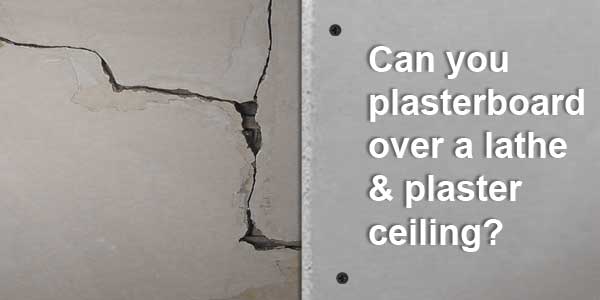Lathe and plaster is an old form of plastering that is very common in properties built before the 1960’s. Since then, modern plasterboard and skimmed plaster has replaced it, as the most popular material used in modern construction.
It is very common to find existing lathe and plaster in older properties. Since it is usually quite old, it is very common for it to have developed issues, mainly due to wear and tear. This can include things like cracking and sagging.
If you own an older property, it is not uncommon to have lathe and plaster that is several decades old. In some cases, it could even be 100+ years old.

If you are renovating or updating a property, you may want to replace the surfaces using modern plastering methods. If this is the case, one of your options, is to remove the old lathe and plaster back to the studwork and ceiling joists below.
One major issue when doing this, is the mess it can create. This is true for both walls and ceilings, but pulling down an old lathe ceiling can be particularly messy.
To avoid the mess and extra labour involved, over boarding lathe and plaster ceilings is a popular alternative. The process is usually much easier and causes far less disruption.
Over boarding also has some other advantages, including:
- Cheaper, due to less labour and removal of waste material
- Less cleaning required after (this can be extensive when removing a lathe and plaster ceiling)
- Over boarding can provide additional sound and heat insulation.
Things to consider before over boarding a lathe ceiling
Although over boarding can be a good solution, there are still things you need to consider, to ensure this is the best choice. Some of the main considerations can be seen below:
- Structural integrity of the existing ceiling – This is important, and you should check the existing lathe and plaster, as well as the joists above. When you add additional plasterboard, you are adding extra weight and this could put additional strain on any existing issues.
- Signs of damp – One common reason for ceiling damage is damp. If this is an issue, the cause needs to be identified and fixed prior to any over boarding. This could be the result of a burst pipe or even something like penetrating damp
Once the damp issue is resolved, the area will also need time to fully dry out. This can be helped with heat and a dehumidifier.
If the ceiling is not dried out properly, this could lead to further issues, such as wood rot, and mould growth. In the worst-case scenario, rot could damage the structural integrity of your timber joists.
In more serious damp cases, over boarding may not be an option, and replacing the ceiling entirely may be a better solution. - Light fixtures and fittings – Because you are adding an additional layer of plasterboard, any kind of recessed lighting fixtures will need to be removed and re-installed to the new ceiling. This could require the assistance of a professional electrician.
- Ensure you are using suitable fixings – You will definitely need to use longer drywall fixings. This will ensure that you go all the way through the existing lathe and plaster. These fixings should also get a strong fixing into the joists below.
Prior to screwing boards up, you will need to locate existing joists. This will ensure that you are always fixing into solid timber. The screws should give a good fixing, as well as pulling the boards up to create a flat even surface. - Lifting and access – Boarding ceilings can be a challenging job. If the boards are being lifted manually, you will need two people and a suitable working platform to install the boards.
Another option that can make the job easier, is a plasterboard lift. This can be used to lift the plasterboard into place while you screw it up. - Correct PPE – As with any job, there is the risk of injury, as you are working with boards overhead, it is recommended that you wear a helmet. Also, there will be plasterboard dust and additional dust from the lathe an plaster. Therefore, eye protection and a dust mask will keep you safe as you carry out the work.
Conclusion
You can definitely plasterboard over a lathe and plaster ceiling. In many cases, it is better than pulling the old ceiling down. This is mainly due to extra work, mess, and expense that is cause by lathe ceiling removal.
Removing this type of old plaster is extremely messy. Not only are you creating dust and debris from the plaster, but there is often decades of dust build-up. The result is a thick black dust, that is very unpleasant.
The advantage with over boarding, is it completely removes this issue, and the process is basically the same as boarding any other ceiling. Generally, it is quite simple, causes very little mess and the disruption and following clean-up is minimal.




